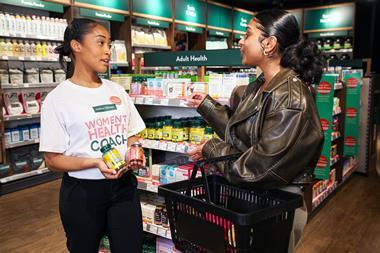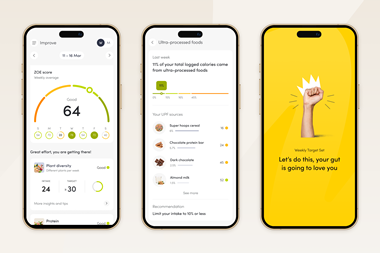The healthcare category is in fine fettle. And it’s innovation and new launches that are sending shoppers reaching for the remedies. Alison Coleman reports
Given that we're a nation of pill takers, growth in the over-the-counter healthcare sector seems surprisingly low, with total OTC and healthcare sales up just 1% in value and 0.8% in volume [Kantar 52w/e 21 February, 2010].
But strip out winter remedies (which will be covered in The Grocer's 23 October focus on feature) and only vitamin and mineral supplements have underperformed.
Every other sub-category has enjoyed value growth despite falling sales among many of the leading brands (see right). So why is the VMS sub-category struggling, what's driving total category growth and why are brands not enjoying their share?
In an economic downturn, you'd expect discretionary purchases to take a hit and vitamin and mineral supplements have done just that both in the branded and own-label arenas. It's perhaps no surprise that consumers don't think the benefits justify the price as far as high-ticket brands go (witness the 7.8% slump in Seven Seas sales, according to IRI).
But that they've also eschewed more modestly priced own-label lines suggests the sub-category has a more fundamental selling job to do especially given the spectacular success of another sub-category perceived to be discretionary and pricey: eyecare.
Eyecare has been one of the big growth stories of the year, sales up a whopping 44% by value and 8.2% by volume, thanks largely to a strong focus on NPD. The disparity between the volume and value growth figures shows that even in difficult economic times, consumers are willing to shell out on innovative new products such as Optrex's ActiMist, launched last year by Reckitt Benckiser. The spray found instant favour with consumers who don't like or can't use eye drops.
"Spraying on to closed eyelids is just so much easier and it immediately bypasses a potential purchase barrier for this group," says marketing director Stefan Gaa. "Eyecare presents real scope for innovation, with a lot of conditions that people don't currently think of as suitable for self-treatment."
Optrex's Allergy Eye Drops will also no doubt have enjoyed strong sales as the incidence of allergies continues to rise. There are now 15 million hayfever sufferers in the UK and the number is growing 5% a year [GSK]. Sales of hayfever remedies have shot up 9% by value and 7.2% by volume as a result [Kantar] and GSK's Piriteze is very much driving growth. Following the launch of 12-tablet boxes of Piriteze, the brand's value share grew 2.7 points, or 40.2%, according to the company, quite an achievement for a relatively expensive product, albeit a heavily promoted one.
Smoking cessation aids are also doing well ironically because consumers are trying to save money. Sales have risen 8% by value and 13% by volume as people try and quit the habit [Kantar], though sales of leading brand Nicorette have fallen [IRI]. Rising stress levels have not just boosted sales of cigarettes and therefore smoking cessation aids, but also of sleeping aids, which are up 2% in volume despite a price-rise driven 16% hike in value [Kantar].
It is no coincidence nicotine replacement therapy products are among a host of once prescription-only medicines and foods that can now be sold over the counter. These days, consumers no longer need to go to the doctor to get tested for chlamydia, they can buy Clamelle (launched November 2008) and test and treat themselves. Heat therapy for joint, arthritic and menstrual pain represents another area of OTC innovation, with heat packs, patches and wraps increasingly sought by consumers for pain management.
Shoppers can also now buy the first non-prescription weight-loss aid to receive an EU licence, Alli, launched in April 2009. The GSK brand has been hugely successful 454,000 units were sold in 2009 but it has sparked some controversy. Under the licence, pharmacists are required to check that a person is over 18 and has a BMI of 28kg/m2 or more. Some assessments of online customers have been less than thorough, and the product has inadvertently been sold to under-18s, prompting calls for tighter restrictions.
There will inevitably be the odd hiccup, but as the likes of Tesco continue to ramp up the number of in-store pharmacies to drive healthcare sales (see left) and the new government looks to cut costs, the migration of prescription-only to OTC looks set to continue.
"The £2bn currently spent by the NHS on treating minor ailments equates on average to £250,000 every year per general practice in England, so GPs, pharmacists and manufacturers will all have a role to play in educating the consumer," says Sheila Kelly, executive director of the Proprietary Association of Great Britain, which represents UK manufacturers of OTC medicines and food supplements. "Many OTC products, particularly some of the newer ingredients that have switched from prescription-only to OTC, give pharmacists the opportunity to offer public health advice on illness prevention and healthy living."
They also offer a great opportunity for manufacturers to innovate and add value to the category with more premium products. But while innovative and new OTC remedies have captured consumers' imaginations and spend, everyday products such as painkillers are still being bought on price. As a result, across the category as a whole, own-label is outperforming branded, with sales up 2.3% by volume, compared with a slide of 0.4% for branded [Kantar].
Sharp inflation clearly hasn't helped branded's cause. On a 12-week rolling study, inflation reached 7% on a like-for- like basket of products, leading shoppers to seek cheaper alternatives. Oral analgesics have only seen a modest 1% increase in value as cheaper own-label products have prospered over the more expensive brands. Reckitt Benckiser's Nurofen may still be the top-selling OTC healthcare brand, with sales of £115m, but these were down 2.5% [IRI].
"Everyday price rather than promoted price is the main reason for buying a particular brand, but force of habit is the next most important factor," says a spokesman for GSK, which makes Panadol and Solpadeine. "They buy because of habit and differentiate based on marketing rather than medical factors. Also, there is interplay between price and the perceived ability of the brand to relieve pain; the lowest price which can be paid for the strongest pain relief," he adds.
The recession may also have impacted sales of gastric remedies volumes fell 1.7% [Kantar] and value sales of leading brand Gaviscon were flat [IRI] which might be a result of fewer boozy lunches.
While gastric remedies and painkillers are a little under the weather, much of the sector is in fine health. And if manufacturers can keep up the innovation, that looks set to continue.
Focus On Healthcare
Given that we're a nation of pill takers, growth in the over-the-counter healthcare sector seems surprisingly low, with total OTC and healthcare sales up just 1% in value and 0.8% in volume [Kantar 52w/e 21 February, 2010].
But strip out winter remedies (which will be covered in The Grocer's 23 October focus on feature) and only vitamin and mineral supplements have underperformed.
Every other sub-category has enjoyed value growth despite falling sales among many of the leading brands (see right). So why is the VMS sub-category struggling, what's driving total category growth and why are brands not enjoying their share?
In an economic downturn, you'd expect discretionary purchases to take a hit and vitamin and mineral supplements have done just that both in the branded and own-label arenas. It's perhaps no surprise that consumers don't think the benefits justify the price as far as high-ticket brands go (witness the 7.8% slump in Seven Seas sales, according to IRI).
But that they've also eschewed more modestly priced own-label lines suggests the sub-category has a more fundamental selling job to do especially given the spectacular success of another sub-category perceived to be discretionary and pricey: eyecare.
Eyecare has been one of the big growth stories of the year, sales up a whopping 44% by value and 8.2% by volume, thanks largely to a strong focus on NPD. The disparity between the volume and value growth figures shows that even in difficult economic times, consumers are willing to shell out on innovative new products such as Optrex's ActiMist, launched last year by Reckitt Benckiser. The spray found instant favour with consumers who don't like or can't use eye drops.
"Spraying on to closed eyelids is just so much easier and it immediately bypasses a potential purchase barrier for this group," says marketing director Stefan Gaa. "Eyecare presents real scope for innovation, with a lot of conditions that people don't currently think of as suitable for self-treatment."
Optrex's Allergy Eye Drops will also no doubt have enjoyed strong sales as the incidence of allergies continues to rise. There are now 15 million hayfever sufferers in the UK and the number is growing 5% a year [GSK]. Sales of hayfever remedies have shot up 9% by value and 7.2% by volume as a result [Kantar] and GSK's Piriteze is very much driving growth. Following the launch of 12-tablet boxes of Piriteze, the brand's value share grew 2.7 points, or 40.2%, according to the company, quite an achievement for a relatively expensive product, albeit a heavily promoted one.
Smoking cessation aids are also doing well ironically because consumers are trying to save money. Sales have risen 8% by value and 13% by volume as people try and quit the habit [Kantar], though sales of leading brand Nicorette have fallen [IRI]. Rising stress levels have not just boosted sales of cigarettes and therefore smoking cessation aids, but also of sleeping aids, which are up 2% in volume despite a price-rise driven 16% hike in value [Kantar].
It is no coincidence nicotine replacement therapy products are among a host of once prescription-only medicines and foods that can now be sold over the counter. These days, consumers no longer need to go to the doctor to get tested for chlamydia, they can buy Clamelle (launched November 2008) and test and treat themselves. Heat therapy for joint, arthritic and menstrual pain represents another area of OTC innovation, with heat packs, patches and wraps increasingly sought by consumers for pain management.
Shoppers can also now buy the first non-prescription weight-loss aid to receive an EU licence, Alli, launched in April 2009. The GSK brand has been hugely successful 454,000 units were sold in 2009 but it has sparked some controversy. Under the licence, pharmacists are required to check that a person is over 18 and has a BMI of 28kg/m2 or more. Some assessments of online customers have been less than thorough, and the product has inadvertently been sold to under-18s, prompting calls for tighter restrictions.
There will inevitably be the odd hiccup, but as the likes of Tesco continue to ramp up the number of in-store pharmacies to drive healthcare sales (see left) and the new government looks to cut costs, the migration of prescription-only to OTC looks set to continue.
"The £2bn currently spent by the NHS on treating minor ailments equates on average to £250,000 every year per general practice in England, so GPs, pharmacists and manufacturers will all have a role to play in educating the consumer," says Sheila Kelly, executive director of the Proprietary Association of Great Britain, which represents UK manufacturers of OTC medicines and food supplements. "Many OTC products, particularly some of the newer ingredients that have switched from prescription-only to OTC, give pharmacists the opportunity to offer public health advice on illness prevention and healthy living."
They also offer a great opportunity for manufacturers to innovate and add value to the category with more premium products. But while innovative and new OTC remedies have captured consumers' imaginations and spend, everyday products such as painkillers are still being bought on price. As a result, across the category as a whole, own-label is outperforming branded, with sales up 2.3% by volume, compared with a slide of 0.4% for branded [Kantar].
Sharp inflation clearly hasn't helped branded's cause. On a 12-week rolling study, inflation reached 7% on a like-for- like basket of products, leading shoppers to seek cheaper alternatives. Oral analgesics have only seen a modest 1% increase in value as cheaper own-label products have prospered over the more expensive brands. Reckitt Benckiser's Nurofen may still be the top-selling OTC healthcare brand, with sales of £115m, but these were down 2.5% [IRI].
"Everyday price rather than promoted price is the main reason for buying a particular brand, but force of habit is the next most important factor," says a spokesman for GSK, which makes Panadol and Solpadeine. "They buy because of habit and differentiate based on marketing rather than medical factors. Also, there is interplay between price and the perceived ability of the brand to relieve pain; the lowest price which can be paid for the strongest pain relief," he adds.
The recession may also have impacted sales of gastric remedies volumes fell 1.7% [Kantar] and value sales of leading brand Gaviscon were flat [IRI] which might be a result of fewer boozy lunches.
While gastric remedies and painkillers are a little under the weather, much of the sector is in fine health. And if manufacturers can keep up the innovation, that looks set to continue.
Focus On Healthcare







No comments yet